Most people face some sort of financial emergency during their lifetime. An emergency could range from home and car repairs, to a job loss or health scare.
And it's usually not easy to pay for these unexpected expenses.
In fact, a 2011 survey by the National Foundation for Credit Counseling showed that 64 percent of Americans don't have enough cash on hand to handle a $1,000 emergency.
"That's why having an emergency fund is important," said JJ Puccio, a State Farm Insurance agent in Statesboro. "With the expenses of everyday life, it is difficult for many people to create a cushion that will help with unexpected costs. But there are some small things all of us can do right now."
Most financial experts recommend setting aside enough money to cover your expenses for at least three to six months. But if you're not already there, don't worry.
It might seem like an unattainable goal, but here are some suggestions to help so that you can be prepared for the unexpected.
1. Determine how much money you need
When you're creating an emergency fund, it's important to be accurate and realistic about what you'll need. Remember, what you spend during good times can usually be pared down when money is tighter.
Also, take a look at your monthly expenses and determine what is a necessity and what is a luxury. Things like cable television, gourmet coffee, and dining out are expenses that can be reduced or even eliminated from your budget during challenging times.
For help figuring out how much you should set aside for emergencies, please use our calculator.
2. Set up a separate liquid account
Put your emergency savings somewhere accessible, but not too accessible.
Your checking or savings account might not be the best place to keep it since you can easily dip into that stash. Instead, save your funds in an account that's liquid-one that is easily convertible to cash, such as a separate savings or money market account.
Once your emergency fund contains more than a few months of expenses, you can consider an alternative, such as a short-term certificate of deposit (CD) with a high annual percentage yield.
3. Set up automatic deposits
If you wait until the end of the month to contribute to your emergency fund, there may be nothing left. Setting up an automated monthly transfer into your emergency account is a great way to make sure you stay on track with your plan.
4. Make your emergency fund a savings priority
It may seem overwhelming to save for three months of expenses or more, but it's important to start somewhere, even if it's somewhere small.
It may help to set an initial goal that's achievable in just a few months, like $1,000. Most importantly, don't touch your emergency fund unless a financial emergency presents itself. When that time comes, you'll be thankful it's there.
This article is sponsored by JJ Puccio, an insurance agent for State Farm in Statesboro. He can be reached at (912) 764-9061, or visit him at 102 N. College St.

